The Nikon D3300 is an entry-level DSLR camera designed for photography enthusiasts and professionals alike․ Featuring a 24․2MP CMOS sensor, it delivers high-quality images with vibrant details․ This user-friendly device is ideal for capturing life’s moments, offering advanced settings and modes to enhance creativity․ The provided manual serves as a comprehensive guide to unlocking its full potential, ensuring optimal performance and creativity in every shot;
1․1 Overview of the Nikon D3300
The Nikon D3300 is an entry-level DSLR camera designed for beginners and hobbyists seeking high-quality images․ It features a 24․2-megapixel CMOS sensor and EXPEED 4 image processor, delivering sharp photos with vibrant colors․ The camera is lightweight and user-friendly, making it ideal for those new to DSLR photography․ With a guide mode to help users understand settings, the D3300 is perfect for learning photography basics․ It also supports Full HD video recording and offers a variety of creative modes to enhance your shooting experience․
1․2 Target Audience for the D3300
The Nikon D3300 is primarily designed for entry-level photographers, hobbyists, and beginners transitioning from compact cameras to DSLRs․ It’s also suitable for photography students and casual shooters seeking a user-friendly device․ The camera’s guide mode and intuitive interface make it ideal for those new to DSLR photography․ Additionally, it appeals to travelers and creatives on a budget who want high-quality images without the complexity of advanced systems․ Its affordability and portability make it a great choice for everyday photography and learning the fundamentals of DSLR shooting․
1․3 Importance of the Manual
The Nikon D3300 manual is essential for unlocking the camera’s full potential, offering detailed guidance for users of all skill levels․ It provides step-by-step instructions to understand advanced features, customize settings, and troubleshoot common issues․ For beginners, it serves as a comprehensive learning tool, while experienced photographers can refine their techniques․ The manual ensures users maximize the camera’s capabilities, enhancing creativity and efficiency․ Regularly referencing it helps maintain optimal performance and familiarity with the device, making it indispensable for achieving professional-quality results and mastering DSLR photography․
Essential Features of the Nikon D3300
The Nikon D3300 offers a 24․2MP CMOS sensor, ISO 100-25600 range, and 6000×4000 max resolution, ensuring vibrant, detailed images for photographers of all levels․
2․1 24․2 Megapixel CMOS Sensor
The Nikon D3300 features a high-performance 24․2-megapixel CMOS sensor, delivering sharp and detailed images with excellent color accuracy․ This sensor captures a wide dynamic range, ensuring vibrant colors and fine details in both bright and low-light conditions․ Its APS-C size provides a balance between portability and image quality, while the EXPEED 4 image processor enhances performance, reducing noise and improving overall efficiency․ This combination makes it ideal for capturing stunning landscapes, portraits, and everyday moments with precision and clarity․
2․2 ISO Sensitivity Range (100-25600)
The Nikon D3300 offers an impressive ISO sensitivity range of 100 to 25600, providing flexibility across various lighting conditions․ At lower ISO settings (100-800), images are sharp with minimal noise, ideal for bright environments․ Higher ISOs (6400-25600) allow shooting in low light, though noise may increase․ The EXPEED 4 processor helps mitigate noise, ensuring usable results even at elevated sensitivities․ This range makes the D3300 versatile for capturing high-quality images in both daylight and dimly lit scenes, giving photographers more creative freedom․
2․3 Maximum Image Resolution (6000 x 4000 Pixels)
The Nikon D3300 captures images at a maximum resolution of 6000 x 4000 pixels, delivering highly detailed and sharp photographs․ This resolution is ideal for enlargements, cropping, and producing high-quality prints․ The EXPEED 4 image processor ensures that the camera processes these large files efficiently, maintaining color accuracy and contrast․ Whether shooting landscapes, portraits, or still-life compositions, the D3300’s resolution provides the flexibility to create professional-grade imagery․ This high resolution also supports precise editing, making it a versatile tool for photographers of all levels․
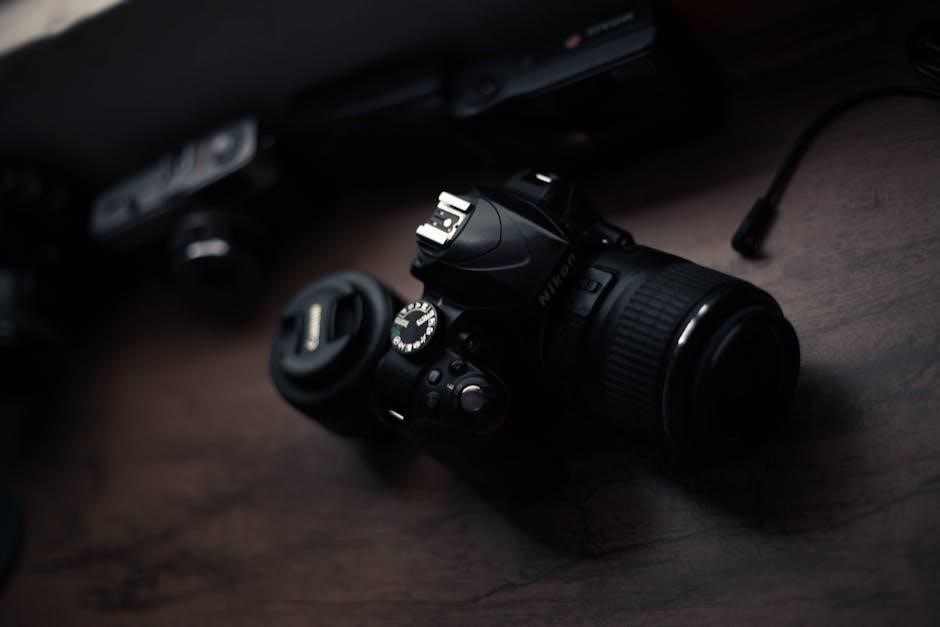
Design and Build Quality
The Nikon D3300 features a lightweight yet durable design, making it ideal for entry-level photographers․ Its compact body is weather-sealed for added protection against elements, ensuring reliability and comfort during extended use․ The camera’s ergonomic grip provides a secure hold, while the intuitive layout of controls enhances user experience․ Built to withstand regular use, the D3300 balances portability with sturdiness, catering to both casual and serious photography enthusiasts․
3․1 Ergonomics and Handling
The Nikon D3300 is designed with ergonomics in mind, offering a comfortable and intuitive handling experience․ Its contoured grip fits securely in the hand, reducing fatigue during extended shoots․ The camera’s lightweight and compact body make it easy to carry, while the strategic placement of buttons and dials ensures quick access to essential controls․ The rubberized texture on the grip enhances stability, preventing accidental slips․ These design elements cater to both novice and experienced photographers, providing a seamless and enjoyable shooting experience․
3․2 Build Materials and Durability
The Nikon D3300 features a durable construction with a lightweight, carbon fiber-reinforced polymer body, making it both sturdy and portable․ While not fully weather-sealed, it offers reliable performance under normal conditions․ The camera’s chassis is designed to withstand regular use, with key components built to last․ The shutter mechanism is rated for 100,000 cycles, ensuring longevity․ Despite its entry-level positioning, the D3300 maintains a solid build quality, providing a dependable tool for photographers seeking a balance between performance and affordability․ Its durability supports both casual and semi-professional use effectively․
3․3 Weight and Dimensions
The Nikon D3300 is designed to be lightweight and compact, weighing approximately 410 grams (14․5 oz) without the lens․ Including the kit lens, it weighs around 650 grams (22․9 oz), making it easy to carry for extended periods․ Its dimensions are 124 x 98 x 76 mm, ensuring a comfortable fit in most camera bags or even a large jacket pocket․ This portability makes it ideal for travel and casual photography, while its ergonomic design provides a secure grip for stable shooting․ The lightweight construction enhances usability without compromising on performance․
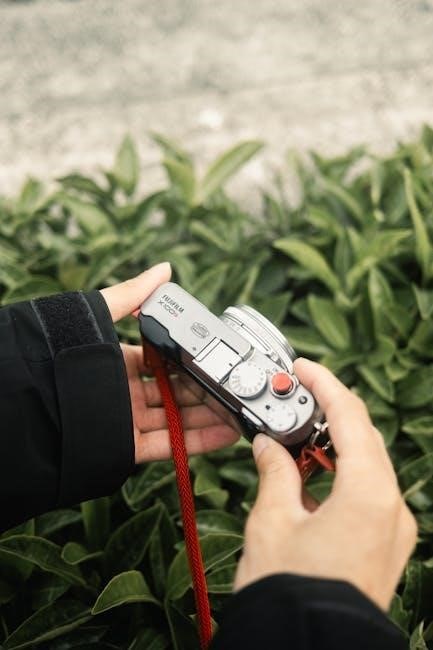
Menu System and Navigation
The Nikon D3300’s menu system is intuitive and well-organized, making it easy to navigate through various settings using the D-pad and OK button, accessible for all user levels․
4․1 Shooting Menu Options
The Shooting Menu on the Nikon D3300 offers a variety of settings to customize your photography experience; Key options include selecting image quality (JPEG or RAW), adjusting white balance, and setting ISO sensitivity․ Autofocus modes and metering options are also accessible here, allowing precise control over focus acquisition and exposure measurement․ Additionally, features like Active D-Lighting and HDR can be enabled to enhance image contrast and dynamic range․ These settings provide flexibility to tailor the camera’s performance for different shooting scenarios and personal preferences, ensuring optimal results in various lighting conditions․
4․2 Setup Menu Options
The Setup Menu on the Nikon D3300 allows you to configure basic camera settings for personalized use․ Options include setting the camera’s date, time, and language, as well as formatting memory cards․ You can also adjust the brightness of the LCD monitor and customize the camera’s auto-shutdown timer․ Additionally, this menu provides options for entering the camera’s serial number for copyright information and enabling or disabling specific features like focus ring rotation․ These settings help tailor the camera to your preferences and ensure smooth operation during photography sessions․
4․3 Custom Settings
Custom Settings on the Nikon D3300 enable advanced users to tailor camera behavior to their preferences․ Options include adjusting autofocus modes, such as AF-A, AF-C, and AF-S, to suit different subjects․ You can also customize metering modes, like Matrix, Center-Weighted, and Spot metering, for precise exposure control․ Additionally, the Custom Settings menu allows you to modify release modes, such as Single Shot, Continuous, and Quiet Shutter, to match your shooting style․ These adjustments enhance creativity and efficiency, making the camera more adaptable to various photography scenarios․
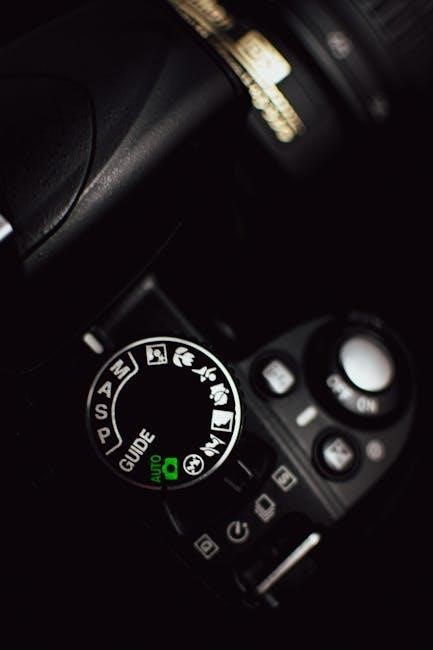
Lenses and Accessories
The Nikon D3300 supports a wide range of NIKKOR lenses, including AF-S and AF-I types, ensuring compatibility and versatility for various photography needs․ Accessories like tripods, flashes, and grips enhance functionality and convenience, allowing photographers to achieve better results and adapt to different shooting conditions․
5․1 Compatible Lenses for the D3300
The Nikon D3300 is compatible with a wide range of NIKKOR lenses, including AF-S, AF-I, and older AF lenses․ It supports DX-format lenses, which are optimized for its APS-C sensor, as well as FX-format lenses, though the latter may not fully utilize their field of view․ Popular options include the kit 18-55mm lens, prime lenses like the 35mm f/1․8G, and telephoto zooms such as the 70-300mm․ Lens compatibility ensures versatility for various photography styles, from portraits to landscapes․
5․2 Importance of AF-S and AF-I Lenses
AF-S and AF-I lenses are crucial for the Nikon D3300, as they enable faster and quieter autofocus performance․ AF-S (Silent Wave Motor) lenses provide smooth, precise focusing, ideal for video recording and still photography․ AF-I lenses, while older, also support fast autofocus․ These lenses ensure compatibility with the D3300’s advanced autofocus system, delivering sharp results․ Using AF-S or AF-I lenses enhances overall camera performance, making them essential for capturing high-quality images in various conditions․
5․3 Recommended Accessories
To enhance your Nikon D3300 experience, consider essential accessories․ A high-speed memory card ensures fast data transfer and ample storage․ A sturdy tripod improves stability for low-light shots․ A polarizing filter enhances colors and reduces glare․ An external flash, like the SB-300, offers creative lighting control․ A lens cleaning kit maintains optical clarity․ A protective camera bag safeguards your gear․ An extra EN-EL14a battery ensures extended shooting sessions․ Lastly, a remote shutter release minimizes camera shake during photography․
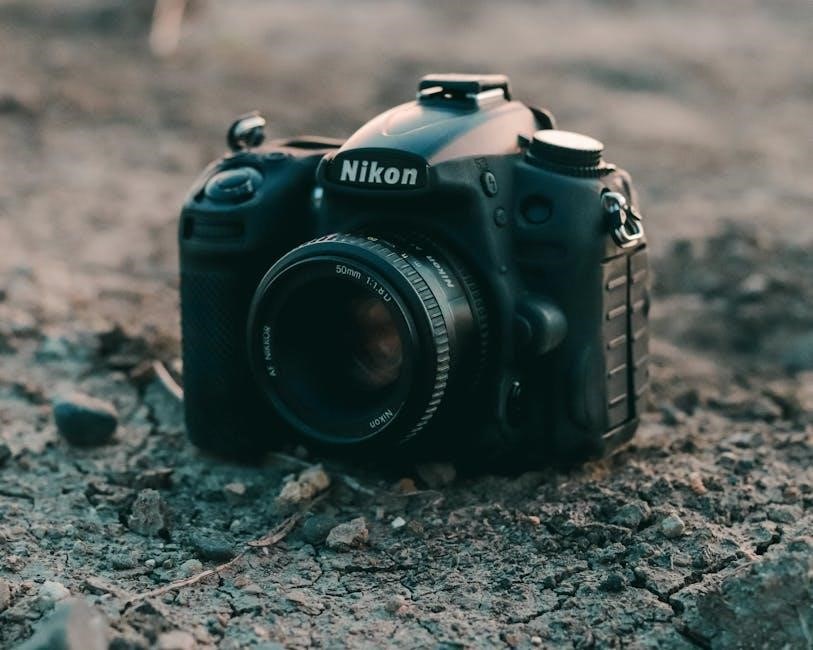
Understanding Exposure
Exposure is the balance of light reaching the sensor, blending ISO, aperture, and shutter speed․ Mastering this trio is key to capturing images with desired brightness and mood․
6․1 ISO Sensitivity and Noise Control
The Nikon D3300 offers an ISO range of 100–25600, allowing flexibility in various lighting conditions․ Lower ISOs (100–800) are ideal for bright environments, minimizing noise․ Higher ISOs (1600–25600) are suited for low light but may introduce grain․ Noise reduction settings can be adjusted in the menu to balance detail and smoothness, ensuring optimal image quality across the ISO spectrum;
6․2 Aperture and Depth of Field
Aperture controls light entry and depth of field․ On the Nikon D3300, aperture is adjusted via the aperture control button or in manual mode․ A lower f-stop (e․g․, f/2․8) means a larger aperture, creating a shallow depth of field, blurring backgrounds․ Higher f-stops (e․g․, f/11) result in a deeper depth of field, keeping more of the image in focus․ Balancing aperture with ISO and shutter speed is key for desired effects․ Experiment with aperture settings to achieve creative control over your photos․
6․3 Shutter Speed and Motion Control
Shutter speed controls the length of time the camera’s shutter remains open, influencing motion capture․ The Nikon D3300 offers shutter speeds from 1/4000 to 30 seconds․ Faster speeds freeze action, ideal for sports or wildlife, while slower speeds create motion blur, great for artistic effects like flowing water or moving clouds․ Use shutter speed creatively to convey dynamic energy or sharp clarity․ Pairing it with aperture and ISO ensures balanced exposure and desired visual effects․ Experimenting with different speeds helps master motion control in various shooting scenarios․
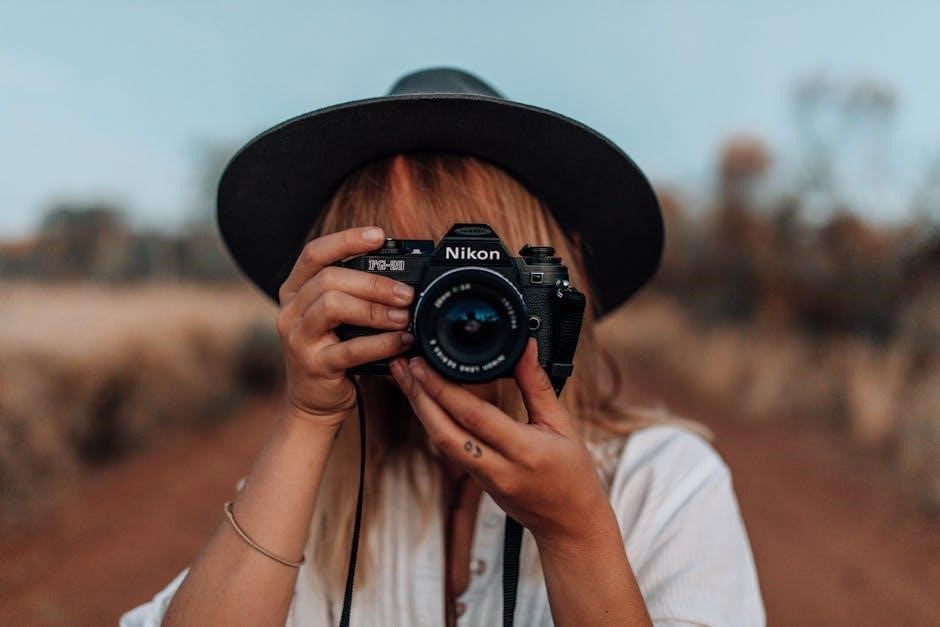
White Balance and Autofocus
White Balance adjusts color tones to match lighting conditions, while Autofocus ensures sharp images․ The D3300 offers various modes for both, enhancing image quality and focusing accuracy․
7․1 White Balance Modes
The Nikon D3300 offers multiple White Balance modes to ensure accurate color reproduction in various lighting conditions․ These include Auto, Daylight, Shade, Fluorescent, Incandescent, Flash, and Cloudy․ Auto mode automatically adjusts based on the scene, while the others are preset for specific lighting types․ Custom White Balance allows users to set a specific color temperature or use a reference object for precise control․ This feature helps in capturing images with natural and consistent colors, enhancing the overall quality of your photography․
7․2 Autofocus System and Modes
The Nikon D3300 features an 11-point autofocus system, offering precise and quick subject tracking․ It includes four AF-area modes: Single-point AF, Dynamic-area AF, 3D Tracking, and Auto-area AF․ Single-point AF focuses on a selected subject, while Dynamic-area AF uses surrounding points for moving subjects; 3D Tracking predicts and follows subjects across the frame, and Auto-area AF automatically selects focus points based on the scene․ The camera also supports AF-S (single servo), AF-C (continuous servo), and AF-A (auto servo) modes, catering to different shooting scenarios like portraits, sports, and dynamic compositions․
7․3 Manual Focus and AI Lenses
The Nikon D3300 supports manual focus for precise control, allowing users to adjust focus using the lens focus ring․ The camera also works seamlessly with Nikon AI (Aperture Indexing) lenses, which provide metering and aperture control compatibility․ When using manual focus, the electronic rangefinder assists by highlighting the in-focus area․ AI lenses enhance functionality, ensuring accurate exposure and focus performance․ This combination of manual control and advanced lens technology offers flexibility for photographers seeking creative precision in their shots․
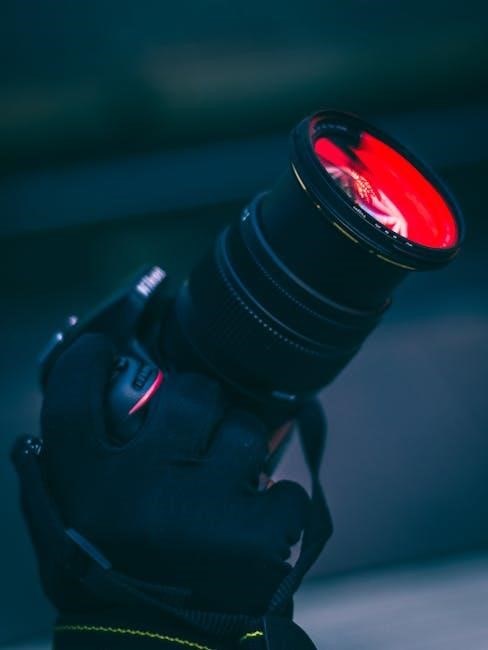
Image Quality and Formats
The D3300 delivers high-quality images with flexible formats, including RAW and JPEG․ It supports various resolution settings and Picture Control options for customizable image output․
8․1 RAW vs․ JPEG Formats
The Nikon D3300 offers two primary file formats: RAW and JPEG․ RAW files capture all image data from the sensor, providing maximum flexibility for post-processing․ JPEG files are compressed and processed in-camera, resulting in smaller file sizes and ready-to-use images․ Shooting in RAW is ideal for professional editing, while JPEG suits casual photography․ The D3300 allows simultaneous capture of both formats, giving photographers the best of both worlds․ Understanding these formats is essential for optimizing image quality and workflow efficiency․
8․2 Image Resolution Settings
The Nikon D3300 allows photographers to adjust image resolution to suit their needs․ The maximum resolution is 6000 x 4000 pixels, delivering high-quality images․ Users can choose from several preset resolutions, including 6000×4000, 4496×3000, and 2992×2000 pixels․ Lower resolutions are ideal for sharing online or saving storage space, while higher settings are best for detailed prints or professional work․ The camera’s menu system enables easy adjustment of these settings, ensuring optimal image quality for various applications․ Balancing resolution and file size is key for efficient photography workflows․
8․3 Picture Control Settings
The Nikon D3300 offers Picture Control settings to customize image processing according to personal preferences․ These settings include Standard, Neutral, Vivid, Monochrome, Portrait, and Landscape modes․ Each mode adjusts parameters like sharpening, contrast, and saturation to enhance specific types of photography․ Users can fine-tune these settings to achieve desired results․ Picture Controls are applied during image processing and can be adjusted in the camera’s menu system․ This feature allows for consistent styling across images, making it ideal for photographers seeking a uniform look in their work․

Video Recording and Live View
The Nikon D3300 supports high-quality video recording and Live View for precise framing․ It offers HD video at 1080p with adjustable frame rates and autofocus during recording․ The Live View mode enhances composition and focus accuracy, making it ideal for both stills and videos․ This feature-rich system caters to creative needs, ensuring sharp and dynamic visual capture․
9․1 Video Recording Capabilities
The Nikon D3300 offers impressive video recording features, capturing HD video at 1080p with frame rates of 60, 50, 30, 25, or 24 fps․ It supports MPEG-4 AVC/H․264 format, ensuring high-quality footage․ The camera features continuous autofocus during recording, reducing blur in moving subjects․ Additionally, it includes manual controls for exposure, enabling creative adjustments․ Built-in stereo microphone enhances audio quality, while optional external microphones can be connected for better sound․ These capabilities make the D3300 a versatile tool for vloggers and enthusiasts seeking professional-grade video performance․
9․2 Live View Mode and Focus
Live View mode on the Nikon D3300 allows precise focus control using the 3-inch LCD screen․ It offers manual focus adjustment with a zoom-in feature for accuracy․ The camera supports Face-Priority AF, Wide-Area AF, and Normal-Area AF modes in Live View, catering to different focusing needs․ A live histogram is also available for exposure preview․ The grid display helps in composing shots, ensuring alignment and balance․ This mode is particularly useful for still photography, enabling detailed focus adjustments and creative composition․
9․3 Video Settings and Quality
The Nikon D3300 offers 1080p Full HD video recording at 60fps, delivering smooth motion and high-quality footage․ Users can choose from various frame rates and resolutions to suit their needs․ The camera supports manual controls during video recording, allowing adjustments to aperture, shutter speed, and ISO for creative flexibility․ Audio quality can be enhanced with the built-in microphone or an optional external microphone․ Additionally, the D3300 allows customization of white balance and Picture Control settings in video mode, ensuring consistent aesthetics across clips․ These features make it ideal for amateur videographers and enthusiasts․
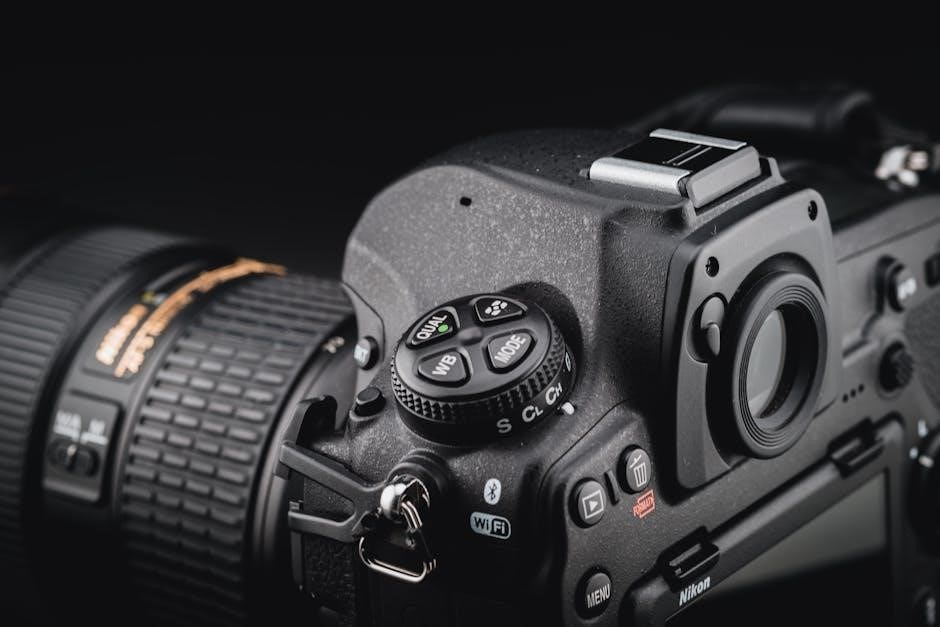
Additional Features
The Nikon D3300 includes a dust reduction system, built-in flash, and external flash compatibility․ It also offers HDR and interval shooting for enhanced creativity and convenience․
10․1 Dust Reduction System
The Nikon D3300 features a built-in dust reduction system designed to minimize dust particles on the image sensor․ This system uses ultrasonic vibrations to shake off dust, ensuring cleaner images and reducing the need for manual sensor cleaning․ It activates automatically during startup or can be triggered manually via the menu․ This feature is particularly useful for photographers who frequently change lenses or shoot in dusty environments․ Regular use of this system helps maintain image quality and reduces post-processing time spent removing dust spots․
10․2 Built-in Flash and External Options
The Nikon D3300 features a built-in pop-up flash with a Guide Number of 12, providing convenient illumination for everyday photography․ It automatically activates in Auto modes and can be manually controlled in other settings․ For more advanced lighting, the D3300 supports external Speedlight flashes via its hot shoe, compatible with Nikon’s Creative Lighting System․ External flashes like the SB-300 or SB-500 offer greater power, bounce functionality, and wireless control, enhancing creative possibilities for portraits and complex lighting setups․
10․3 HDR and Interval Shooting
The Nikon D3300 supports HDR (High Dynamic Range) photography by capturing multiple exposures and combining them into a single image with enhanced tonal range․ While it doesn’t have a built-in HDR mode, users can achieve HDR by bracketing shots and merging them in post-processing․ Additionally, the camera offers Interval Shooting, allowing you to capture images at fixed time intervals, ideal for time-lapse photography․ This feature is accessible via the Shooting Menu, enabling you to set the number of intervals and the time between shots, making it perfect for dynamic scenes like sunsets or traffic․
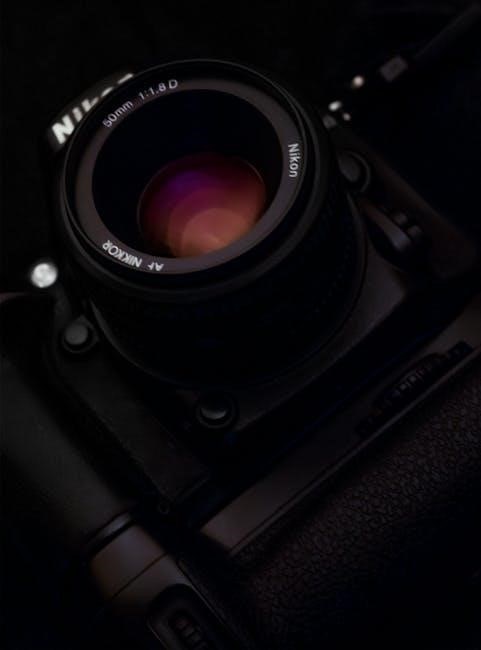
Troubleshooting Common Issues
The Nikon D3300 may encounter issues like sensor dust or battery drain․ Regular cleaning, firmware updates, and proper memory card use help resolve these problems effectively․
11․1 Image Sensor Cleaning
The Nikon D3300’s image sensor may accumulate dust, affecting image quality․ Use the camera’s automatic dust reduction system regularly․ For manual cleaning, turn off the camera, ensure the battery is fully charged, and use a soft, dry blower to gently remove dust․ Avoid compressed air, as it may damage the sensor․ Clean the sensor in a dry environment to prevent moisture damage․ If stubborn spots persist, consult a professional․ Regular cleaning ensures sharp, dust-free images․
11․2 Memory Card Errors
Memory card errors can disrupt shooting sessions․ If the D3300 displays an error, first turn it off and restart․ Remove the card, clean its contacts with a soft cloth, and reinsert it․ Ensure the card is compatible and formatted correctly․ Use the camera’s Format option to initialize the card․ If issues persist, try a different card or reformat the card on a computer․ Avoid using cards with unsupported file systems․ If errors continue, the card may be faulty and need replacement․ Always handle cards carefully to prevent damage․
11․3 Battery and Charging Issues
If the D3300 fails to power on, check the battery level․ Ensure the battery is properly seated and the contacts are clean․ Use the provided charger and avoid third-party adapters․ If charging issues occur, reset the camera by pressing the shutter and power button simultaneously․ Allow the battery to charge for at least 30 minutes․ Avoid extreme temperatures during charging․ If the battery drains quickly, it may need calibration․ Replace the battery if problems persist despite troubleshooting․ Always use Nikon-approved batteries for optimal performance and safety․
Maintenance and Care
Regularly clean the camera and lens to prevent dust buildup․ Store the D3300 in a dry, cool place away from direct sunlight․ Use a soft cloth to wipe surfaces and avoid harsh chemicals․ Check and update firmware periodically for optimal performance․ Proper care extends the camera’s lifespan and ensures reliable operation․
12․1 Cleaning the Camera and Lens
Regular cleaning is essential to maintain the Nikon D3300’s performance․ Use a soft, dry cloth to gently wipe the camera body and avoid harsh chemicals․ For the lens, use a microfiber cloth and a blower to remove loose debris before wiping․ Avoid touching the sensor; if necessary, use a cleaning brush or swab․ Never apply cleaning solutions directly to the lens or sensor․ Proper cleaning prevents dust spots and ensures sharp, clear images․ Always handle the camera and lens with care to minimize scratches and damage․
12․2 Storing the Camera Properly
Store the Nikon D3300 in a cool, dry place to prevent moisture damage․ Use the original camera case or a protective bag to shield it from dust and scratches․ Avoid extreme temperatures, as they can harm the battery and internal components․ Keep the lens capped when not in use to protect it from dust and fingerprints․ Store the camera with the battery partially charged to maintain its health․ Avoid leaving the camera unused for long periods without proper maintenance․ Always ensure the camera is clean and dry before storing it․
12․3 Updating Firmware
Regularly update the Nikon D3300’s firmware to ensure optimal performance and access to new features․ Visit Nikon’s official website to check for the latest firmware version․ Download the update to your computer, then connect the camera via USB․ Ensure the camera is fully charged and in Manual mode․ Follow the on-screen instructions carefully to avoid interruptions․ Do not disconnect the USB cable or turn off the camera during the update․ After completion, restart the camera and verify the firmware version in the setup menu․ Updates enhance functionality and fix potential issues․